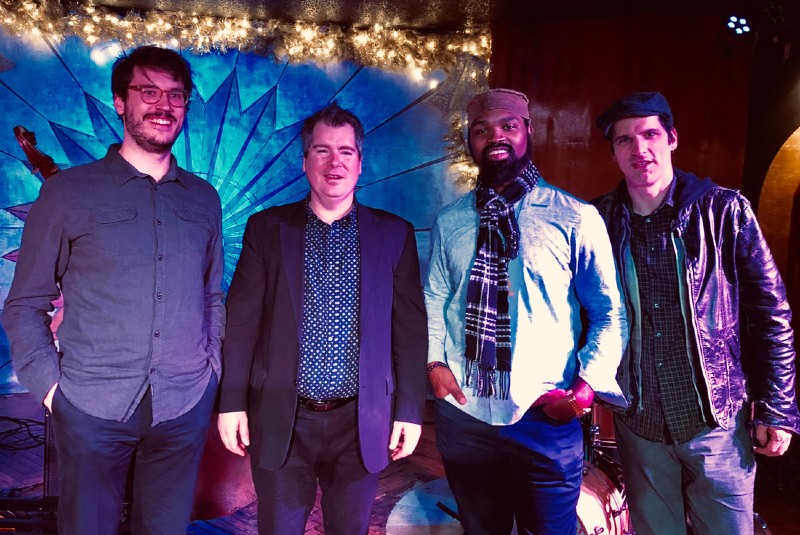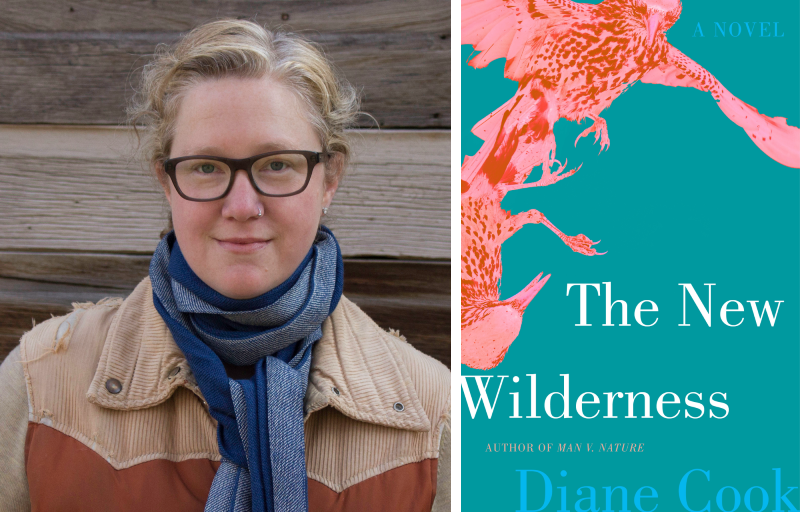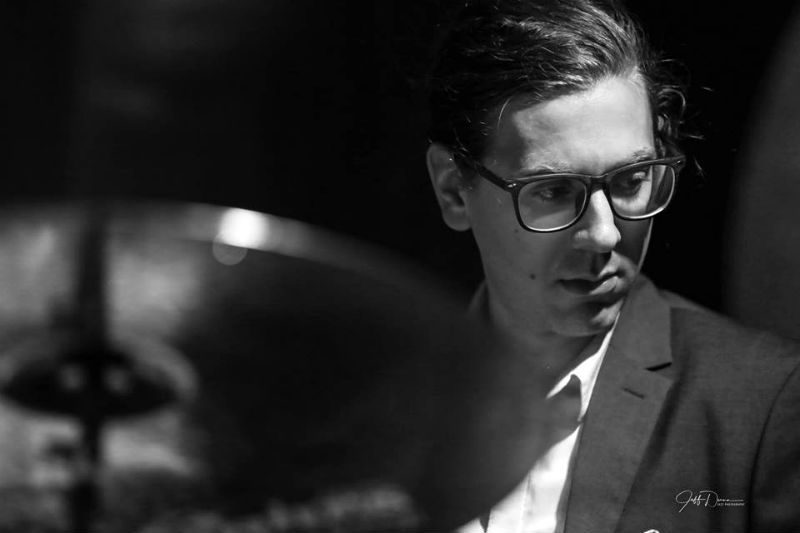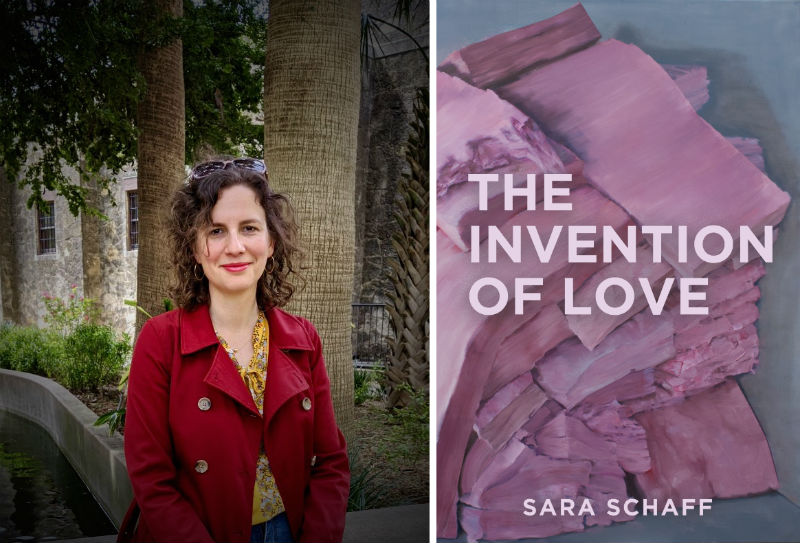The Rob Crozier Jazz Ensemble is "Live" once again

Like most musical groups, the Rob Crozier Jazz Ensemble spent much of 2020 in quarantine due to the pandemic.
But Crozier managed to keep the creativity flowing by digging into live recordings the group made at Grosse Pointe’s Dirty Dog Jazz Cafe in February 2019, and the result is the Ensemble's first live album.
Live is a nice mix of funky fusion, straight-ahead jazz, and world music, featuring tunes from Crozier's last two studio albums, Tall Trees (2017) and Ocean Blue (2018), plus a couple of new songs. For this album, the Ensemble consisted of bassist Crozier, Rafael Statin on reed instruments, pianist/keyboardist Keaton Royer, drummer Rob Avsharian.
Crozier and Co., who were always active playing area stages and festivals before the pandemic, recently started performing again to socially distanced crowds as part of the ongoing series Jazz After Dark at Weber’s Restaurant.
In advance of the album’s release concert at Weber's on September 5, I emailed with Crozier about Live and how he stays creative during the pandemic.
Jazz pianist, Juno Award winner, and U-M professor Andy Milne guides us through his new album, "The reMission"

When jazz pianist Andy Milne moved to Ann Arbor in 2018 to become an assistant professor of music, jazz, and contemporary improvisation at the University of Michigan, he didn't know he would win the 2019 Juno Award for Jazz Album of the Year by a group for The Seasons of Being record with his Dapp Theory ensemble.
But Milne did know he had survived prostate cancer in 2017, so winning Canada’s Grammy equivalent was a nice side note to, you know, being alive.
After recovering from cancer but before moving to Michigan, Toronto-area native Milne, who had lived in New York City since the early 1990s, also started the Unison trio featuring drummer Clarence Penn and bassist John Hébert, composing stripped-down music that is the opposite of Dapp Theory’s fractured-funk polyphony, which features a multitude of instruments and voices. The trio released its debut album, the contemplative The reMission, in April and had planned a tour for May, which the coronavirus pandemic wiped out.
While Milne was disappointed he wasn't able to promote The reMission, he's used the downtime to get acquainted with Ann Arbor now that his wife, the singer and Oberlin College and Conservatory educator La Tanya Hall, was finally able to join him in Michigan.
Plus, he looking forward to diving into what the University of Michigan has to offer in terms of combining his interests in pairing music with science and research.
“I realized when I came here, my primary focus was like, ‘Oh, I’m coming to Ann Arbor to take this teaching position and really embrace a role in the university community,’ both within [the school of] music, theater, and dance and just exploring where my path and where my place would be in the university,” Milne said. “So, I’ve been collaborating with faculty and researchers in different areas of the university for public health and these kinds of things. I’m finding where my zone will be inside of that.”
Combining music with other disciplines has long informed Milne’s work, including Dapp Theory’s The Seasons of Being, which coalesced around ideas he learned while treating his cancer with homeopathy, and the documentary soundtracks he’s composed for Capt. Kirk himself, William Shatner. (The reMission’s “Vertical on Opening Night” is named after something Shatner said in one doc.)
Being at a large research university like Michigan means Milne can continue to explore cross-disciplinary creativity, all in a town he finds welcoming and easy to navigate.
“I think it’s probably just the proximity of everything,” Milne says of Ann Arbor. “The fact that I’m living close to my work, and people are super-friendly here, and there’s great restaurants. I mean, it’s a really livable city, and I’ve been able to get out and enjoy riding my bike and exploring neighborhoods and things like that. I like the feeling here.”
While Milne wasn't able to go out and promote The reMission, he did give us a song-by-song tour of the new album, which you can listen to below on Spotify as you read his commentary.
Diane Cook's novel "The New Wilderness" envisions a world after extreme climate change

Imagine being dropped off in the wilderness, uninhabited except for 19 people with you and rangers who patrol the land. Modern amenities are nonexistent, but the upside is that the air quality is much better than the polluted city. You live nomadically and hunt, fish, and gather to survive. This is not an extended camping trip. It is your new way of life.
This intense scenario forms the premise of Diane Cook’s new book, The New Wilderness, a speculative novel involving relationships and the environment—and how the latter influences the former. The novel has landed on the long list for the Booker Prize. Cook has taught for the University of Michigan, is a U-M alum, and lives in Brooklyn, New York.
In a joint virtual event, both Cook and Karolina Waclawiak, whose new novel Life Events was just published, will read and discuss their new books through the At Home with Literati series Monday, August 31, at 7 pm.
The characters of The New Wilderness, including Agnes, her mother Bea, and her mother’s husband Glen, go to the wilderness as part of a research experiment to determine whether this lifestyle is sustainable. Bea joined to save Agnes’ life. Agnes was five years old when they arrived and gravely ill from the effects of pollution. Despite learning how to stay alive in the wild and improving Agnes’ health, the characters’ memories of their former life, their love for one another in all its forms, and the burden of subsisting clash and inform their individual choices.
Early on, Bea’s concerns emerge when considering their next journey to a ranger post farther than they’ve had to go before:
Glen hooked his arm around her neck and pulled her close. “Now, now,” he murmured. “This will be fun.”
She knew that a big part of Glen believed this. But no part of Bea did. She pictured the map in her head again and saw all that unknown land, that beige parchment, all that nothing. They would be changed on the other side of it, that much she knew. Not knowing how was only one of the things that scared her.
The New Wilderness calls into question what the natural world is and should be, while also showing how vast the wilderness within and between people can be.
I interviewed Cook about this book and her writing.
Innovation & Education: "Welcome to Commie High" documents the history and influence of Ann Arbor's legendary school

This article originally ran March 25, 2020.
We're rerunning the story to highlight the launch of the "Commie High" archive at aadl.org/commiehigh:
This site serves as a supplement to the independent, feature-length documentary about Community High School in Ann Arbor, MI—produced by 7 Cylinders Studio—providing extensive extra content available for public viewing and research. Additional materials and development are anticipated in future editions.
There are video extras, historical and making-of-the-film photos, a music database documenting the school's numerous bands and musicians, digitized yearbooks, and news articles.
The coronavirus pandemic is forcing teachers and administrators to improvise ways to serve their pupils academically, mostly through virtual learning and online academies. Other imaginative approaches will be introduced as the pandemic drags on, spotlighting the skills of educators and showing how resourceful they can be when not stuck on a treadmill of prepping kids for standardized tests.
But one school in Ann Arbor has been using innovative educational approaches for nearly 50 years.
Ann Arbor's Community High School started in 1972 with a "school without walls" concept. A handful of other schools across the country adopted similar approaches, where structured curricula were abandoned in favor of flexible programs that best fit individual students' needs, with a focus on real-world education.
But the Community model never expanded deeply into the mainstream.
Until now. (Kinda.)
A heavily modified variation of Community's wall-free education approach is being tested during the coronavirus pandemic, and it seems inevitable that some of these outside-the-box ideas will be incorporated into schools once this over and society deals with our new normal.
Welcome to Commie High, a new documentary by Ypsilanti-based filmmaker Donald Harrison, shows the school's unique approach to education, from its hippie-era beginnings to its place in the modern landscape, talking to students and teachers from the past and present about what makes Community special -- and effective.
The movie was to premiere as part of the 58th Ann Arbor Film Festival (AAFF). But with the entire event being moved to a livestream on Vimeo due to the lockdown, Harrison and the AAFF are are offering Welcome to Commie High as fundraising rental. The movie will be available to rent for $9.99 from 10 am, March 30 to 10 am, April 1; each rental will be active for 48 hours. The rental fee will be split two ways: 50 percent of the proceeds will go to the AAFF to help offset costs and the rest will be put toward the distribution of the documentary. Click here to pre-order the rental.
Harrison answered some questions via email about Welcome to Commie High.
Jesse Kramer's "Antinous as Osiris" interprets Roman passion and New York jazz through the lens of a Washtenaw County upbringing

This story originally ran June 12, 2019.
For roughly half a decade, the Roman emperor Hadrian was in love with a man who was not his spouse. Between 125 CE and 130 CE, the Greek youth Antinous became a favorite of Hadrian, and for the final two years of the latter's life they were side by side touring the Roman empire.
After Antinous' surprise death on the Nile, Hadrian was devastated and, in his grief, proclaimed his lover a deity, In turn, priests connected Antinous to the Egyptian god Osiris, lord of the underworld, afterworld, and rebirth.
Et voilà:
Nearly 2,000 years later we have Antinous as Osiris, the latest album by Ann Arbor jazz drummer Jesse Kramer.
Not a Fake Ad: I Spy two new books from the Ann Arbor Observer highlighting its beloved monthly contests

If you live in the Ann Arbor school district, you are a recipient of the Ann Arbor Observer. The monthly magazine offers in-depth reporting on local issues and residents, a robust calendar of area events, and two long-running contests that are often the first things to which readers turn: "Fake Ad" and "I Spy."
If you're a superfan of these challenges, you won't have to wait until the next Observer arrives because the magazine is publishing two books of highlights from the contests: I Spy…Architecture: Photo Puzzles From the Ann Arbor Observer, Vol. 1 by Sally Bjork and The Fake Ad Book: 47 of the Best Fake Ads of All Time by Jay Forstner.
Forstner has worked on "Fake Ad" since the early 1990s when he had his “dream job” of being a staff writer for the Observer.
“I came up with the 'Fake Ad' as a way of trying to contribute more to the Observer because I loved the publication and the people I worked with," Forstner says. "The funny thing is that in the first years after I started writing the 'Fake Ad,' I also wrote some of my best articles for the magazine. I think the 'Fake Ad' was my way of connecting with my work.”
Bjork proposed the "I Spy" feature to editor John Hilton in late 1998.
“It originally focused on historic architecture and eventually expanded to include other things," Bjork says. "It began in February of 1999 and, thankfully, it has been going ever since."
Picking favorites from these beloved features proved difficult for both writers. Forstner recalls the fake ad for the Victorious Egret lingerie shop for ornithologists. “It combines three of my passions: wordplay, sexy lingerie, and bird watching," Forstner jokes, "which are very difficult to pursue all at the same time, sadly.”
Female protagonists populate U-M MFA graduate Sara Schaff's new collection of short stories

What you have. What you want. What you hang on to. What you give up.
Jeans. A house. A spouse. Drawings. Places. Jobs. A fantasy.
Sara Schaff’s second collection of short stories, The Invention of Love, invests in these questions of possession and ownership, of affiliation and surprising loss. The best way to understand the characters’ distinct circumstances and the fine lines between one version of their life or another that they choose, or that gets chosen for them, is by looking at the plots themselves. For example, two half-sisters lose their mother, and both covet her pair of jeans used for dancing in “Our Lady of Guazá.” In another story called “Noreen O’Malley at the Sunset Pool,” Noreen must let go of the narratives about her friends and lovers that she hoped for as she cares for her new baby.
Still, a character may make a delightful discovery amidst a seemingly unbearable situation, such as a woman eventually becoming enthralled by Anna Karenina despite the fact that her ex-husband’s new wife (and their family friend) had been the one who recommended the book. These observant views of these women show their realizations and complicated hardships as they navigate life and its turns.
Schaff will speak with Greg Schutz, writer and lecturer at the University of Michigan, in an At Home with Literati virtual event on Tuesday, July 21, at 7 pm. Schaff and Schutz are friends and fellow graduates of the MFA program at the University of Michigan. Information to join via Zoom is on the event webpage. We corresponded via email beforehand, and here are my questions and Schaff’s responses.
Two lifelong friends challenge each other to write new songs on the No More Covers podcast

Michigan natives Chris Erickson and Hadley Robinson have been friends since birth.
“Before birth, actually," Erickson says. "Our dads grew up together, our grandmothers went to college together and they lived on the same street in Midland.”
The two stayed in touch through adulthood as each became artists in different ways.
Robinson is a video producer based in Brooklyn: “My background is in journalism, I used to be a newspaper writer. I’ve worked in video full time for the past five years while dabbling in audio, which has been helpful with this endeavor.”
Erickson teaches in the IB program at Huron High School where he also serves as the creative activity service coordinator, guiding students to find and pursue their creative interests.
A new single from Ann Arbor's Dani Darling takes on social-media weirdness during lockdown

Ann Arbor singer-songwriter Dani Darling and her bandmates were recording a new EP in a studio when the Covid-19 stay-at-home order began. The Reverie EP is still on track for release this summer, but the first single, "S+M," features Darling solo.
"I found myself with those sessions and more to say, so I went back to doing my bedroom pop, late-night studio sessions," Darling said. "The beat is by a London producer GC Beats. Really just sounded like Dani when I heard it."
"S+M" features jazzy guitar chords over a slow-groove R&B beat with Darling's ethereal voice floating over the mix. She sings playful puns to tell her tale about what it feels like to be a musician in lockdown.
"'S+M' is a snapshot of my experience during the stay-at-home order -- my music career on hold indefinitely, feeling social media shift from a strength to something sinister," Darling said. "If felt like a scramble for the airwaves, like either you shut down and take time for yourself or you dive right in and try to make a wave, make a difference. I wanted to do that because I don't think of my music as purely entertainment -- it's a way to connect and healing is a big theme in this project. So I wanted to make an impact, but it started to feel like an unhealthy relationship. Sometimes you go online and you know you shouldn't; sometimes you go look at someone's [social] media knowing it will hurt and do it anyway. Sometimes people form an unhealthy relationship to you as fans."
Ann Arbor's WSG Gallery lost its lease on Main Street and upped its online offerings
Pulp received an email on May 7 from representatives of WSG Gallery, the longstanding Ann Arbor artist collective that had space at 306 S. Main St., saying, "Our landlord notified us that he has already contracted with construction people to dismantle walls and etc from the interior of the gallery on 5/27. He plans to put a 'FOR RENT' sign in the front window."
The email went on to discuss surprise and dismay on behalf of the WSG artists, and I asked some follow-up and clarifying questions in order to write a post. But after saying they would discuss my questions and get back to me, I never heard back from WSG.
But that's not because anything had changed with WSG's sudden eviction; it's because the gallery decided to press ahead with its new life online.
"At this point we are dedicated to moving forward," wrote WSG Gallery president Valerie Mann in a June 18 email. "We are out of our old space and busting our tails with our online gallery. We are having great success with sales so far and are really pleased! Our strength is really in our people. I mean, I have 83 year olds learning how to build web pages!!!"


































